Sales engagement process, tips, and more: A guide by an SDR team lead

SDR Team Leader at Reply.io
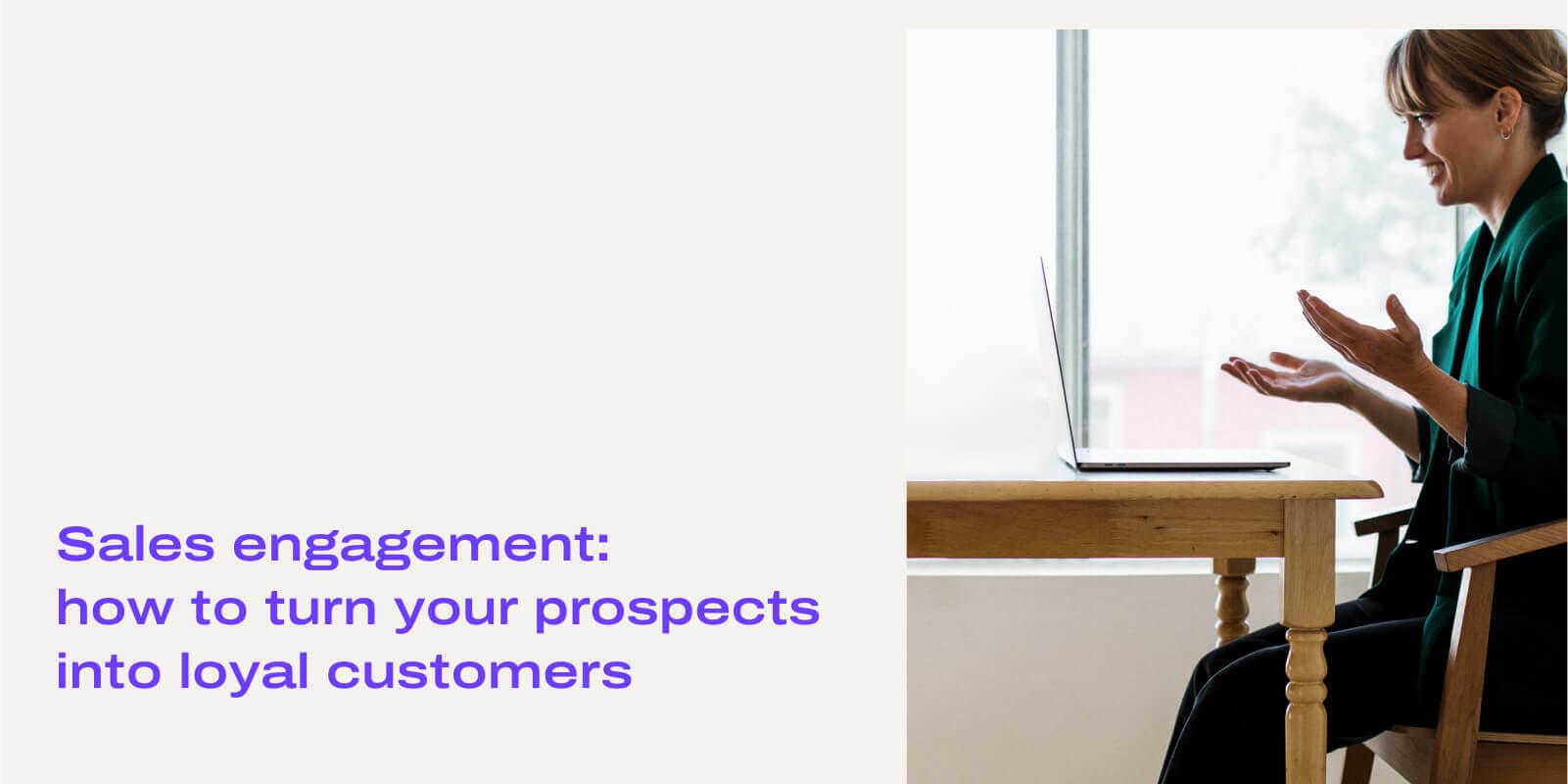
Tags
Share
In the past decade, we’ve witnessed a major shift in buyer behavior. The sales cycles have been growing longer mostly because buyers prefer making informed and research-driven decisions.
According to Gartner, B2B buyers spend around 45% of their time on research (vs only 17% on meeting the potential suppliers) when considering a purchase.
Your prospects also have developed visibly higher expectations when it comes to sales interactions and buyer experience in general. It’s no longer enough to hook a prospective buyer with a catchy ad or the cheapest price.
The modern buying decisions are the result of elaborate sales engagement efforts and are mostly relationship-driven.
As the team lead for Reply.io’s SDR team, there are some sales engagement tactics that have worked well in the past. I’ll walk you through how to build your own strategy to connect with the prospects and turn them into loyal customers.
What is sales engagement?
Sales engagement refers to the combination of targeted interactions between a salesperson and a prospect throughout their buyer journey.
The keyword here is “targeted” because there might be thousands of customer interactions between the buyer and the seller. However, the intent and outcomes might differ depending on the current stage of the sales process.
For example, optimizing your content to pop up in the search results for relevant keywords helps you build awareness, generate traffic, or even capture a lead or two. Using cold call software to reach out to the prospect via phone or email, on the other hand, would be a more proactive gesture that aims to evoke a response while also helping the prospect learn about your product.
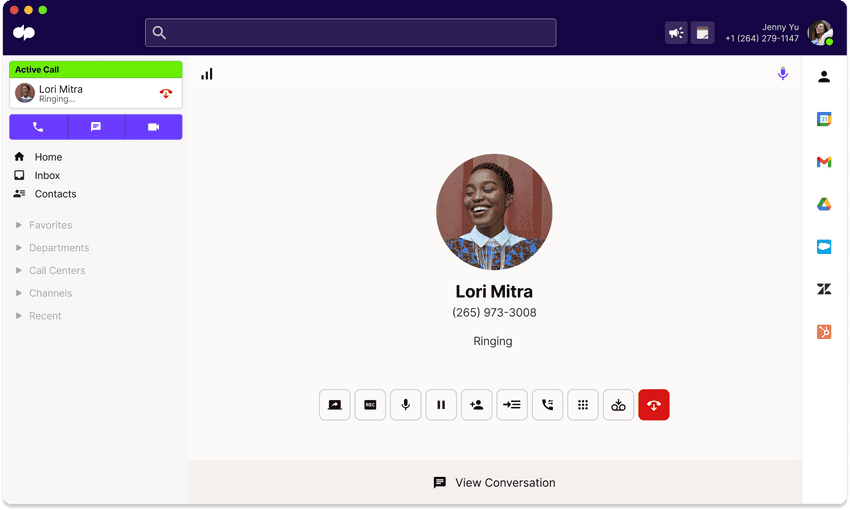
That said, sales engagement activities usually start with the first contact between the sales professionals and the prospects. And it doesn’t matter whether it’s inbound (webinar signup) or outbound (cold email). Their primary goal is to establish genuine personal relationships by building trust, offering guidance and value before the actual purchase.
The benefits of a efficient sales engagement activities
But why is sales engagement such a big deal? Why should you bother with any extra effort when a prospect has already “taken your bait” (as in the case of inbound engagement) or responded to your sales outreach?
Well, there are many reasons you should care about and invest in adoption of sales engagement tactics. Here are a few:
Predictable pipeline. With a sales engagement effort, you take a proactive part in your prospect’s buying journey, helping them move through your pipeline faster and with a higher probability to close. As a result, you can build and maintain a steady flow of leads for your business.
Better customer relationships (that results in loyalty and repeat purchases). As mentioned above, sales engagement is all about rapport building. This leads to loyalty and repeat purchases, allowing you to grow your customer’s lifetime value.
Improved visibility and transparency into the sales processes. Sales engagement efforts are usually orchestrated by a dedicated tool that collects your data and provides actionable insights into your funnel. This allows you to make informed decisions and fine-tune your sales processes for maximum performance.
Increased sales productivity and optimized effort. Another benefit any good sales engagement platform can offer is the ability to automate routine sales tasks and empower your sales reps with the tools to boost their performance, both individually and as a team.
What does a typical sales engagement process look like?
The sales engagement process mostly aligns with the key stages of the sales cycle. In general, it consists of a set of touchpoints over a certain amount of time. For example, here’s how a typical outbound sales engagement process would look like in the B2B SaaS niche:
Prospecting: getting the potential prospect on your list.
Research/qualification: making sure the prospects actually match your ICP (ideal customer profile) and finding the best way to approach them.
Outreach: getting in touch with the prospect.
Negotiation and nurturing: meeting the prospect for a demo, presenting the solution, handling objections, etc.
Closing: making a sale.
Retention: maintaining relations with the customers to upsell or get referrals later on.
Depending on the current stage of the process, the touchpoints between a seller and a buyer might be either manual or automated, and happen across a number of different communication channels. For the outreach stage, this will be mostly email or social media, whereas negotiations happen mostly over a business phone call or a virtual meeting.
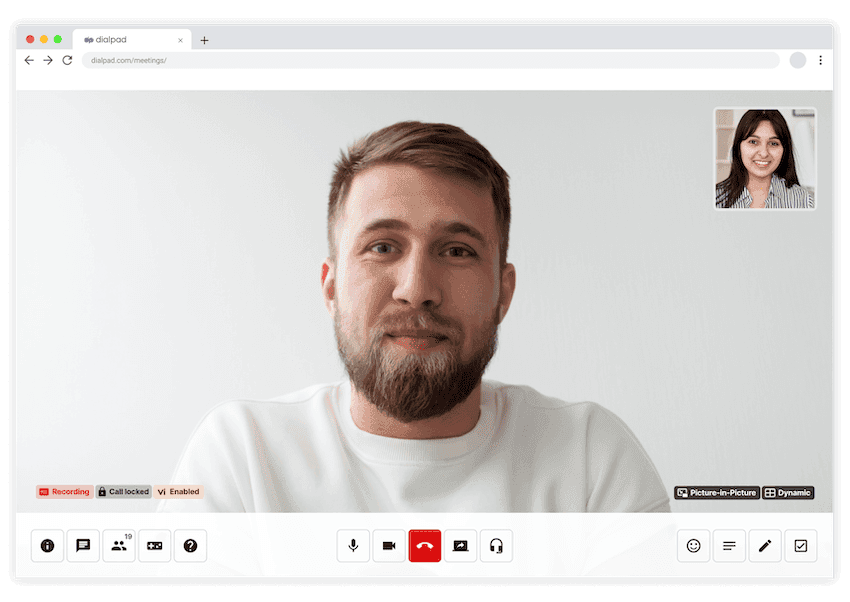
3 common mistakes that might ruin the best sales engagement strategy
It’s no secret that a formal sales process is one of the things that set the high-performing sales teams apart. When it comes to sales engagement, things aren’t very much different.
To make sure all of your SDRs consistently hit their targets, build a thought-out, structured process they can follow. So, before you set up your first sequence, map out a typical buying process your prospects go through. Detail on what happens at each stage of their journey, along with the channels involved, typical priorities and considerations they make, etc.
Once you understand the process, you can move on to build a strategy around it.
1. Understand the key elements of a winning sales engagement strategy
According to the TOPO's 2020 Sales Development Leadership Report, defined strategy is among the most important factors for sales engagement success along with automation and personalization (which we will address later). But it is also among the top challenges for 25% of the surveyed sales leaders.
So, if you need some guidance to get started with building a winning sales engagement strategy, here are some of the key elements to consider:
Targeting (ICP)
Playbooks
Sequences
Channels (and touchpoints)
Automation tools
Analytics
Targeting (ICP)
To know how to engage your prospects in the best way possible, start with understanding who they really are. If you already have a documented buyer persona (or ICP), make sure it’s up to date, accurate, and data-backed. If you don’t have one, start with an in-depth analysis of your current customer base and market research.
If an ICP is a more high-level document that covers firmographics, technographics, psychographics, and use cases for your product, the buyer persona is a more detailed image of your target audience. Namely, there are at least three persona types you need to document: decision-maker, evaluator, and influencer.
Must-have items to describe for each one are:
Possible titles
Responsibilities
Items to get buy-in (collateral or any other means that might influence this persona)
Why should they care about your product?
Challenges and pain points
Desires/requirements
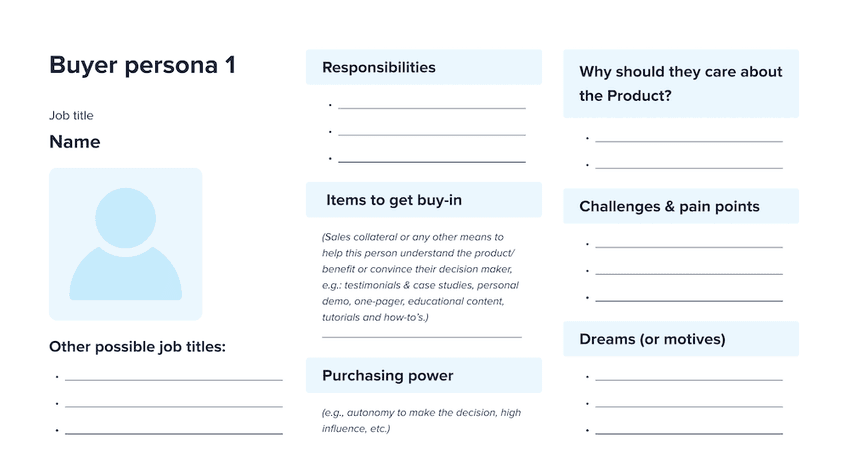
Playbooks
As your next step, you need to figure out the typical scenarios for interacting with the prospects. For example, what’s the process for handling demo requests? How do you process the inbound leads from content? What’s the process for outbound outreach?
Draft the common flows for any situation or process you can think of (don’t worry, you will be able to add more as you move forward) and have your SDRs not only get familiar with them but also follow closely in their daily sales activities.
Having those cheat sheets documented as formal SDR playbooks will help you avoid some typical mistakes and deliver a consistently positive buyer experience.
AI can play a unique and helpful role in this process. With Dialpad's Ai Playbooks feature, for instance, coaches and supervisors can track rep adherence to sales methodologies like BANT, SPIN, and SPICED more easily. Dialpad Ai can automatically suggest questions and phrases that they need to say during a call (for example, asking about budget or purchase timelines), understand whether the behavior was met, and check the task off the list (or notify managers if this isn't being done):
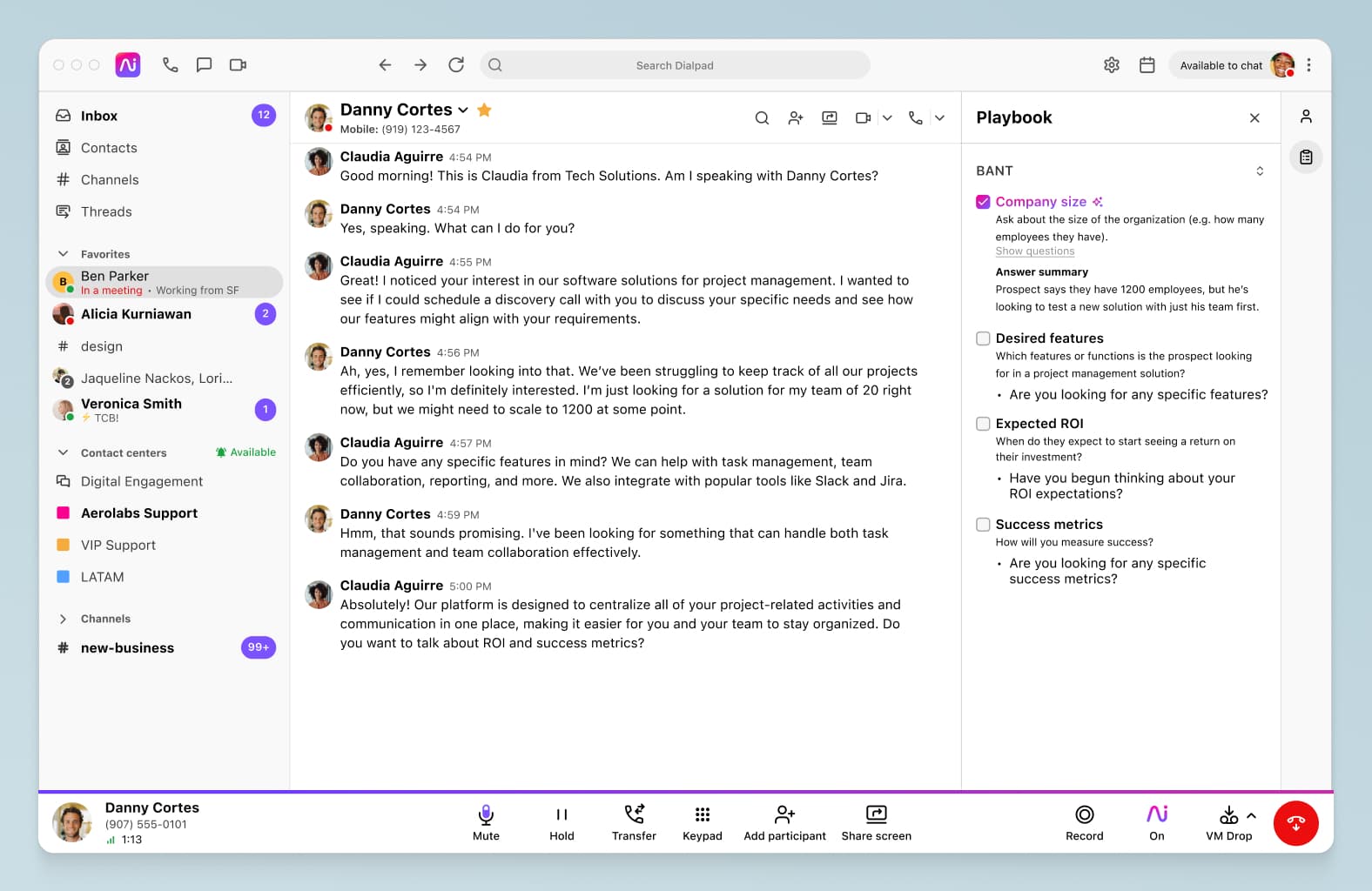
This is helpful for sales leaders, because they don't have to painstakingly review every single call, and can quickly tell which reps need additional coaching or if any parts of the methodology can be improved upon—all thanks to AI.
Sequences
If sales playbooks typically focus on what you need to do, sequences allow you to lay out the process for how to do that. Namely, you need to create the corresponding sequences for each of the sales engagement scenarios to minimize the manual work down the road.
Some of the must-have sequence types you should have in your sales engagement platform are:
Outbound (tier 1-3 leads)
Inbound (e.g., trial sign-ups and demo requests)
Website hand-risers (live chat, contact form, call attempts, etc.)
Downloaded content
Trial-not-converted leads
Intent-based (inbound and outbound)
Auto-reply and OOO
Each of the sequences should have a set of steps and email templates customized for the given scenario. The number of steps, their types, and frequency will vary greatly depending on the use case. For example, here’s how an outbound sequence compares to the inbound one (trial sign-up).
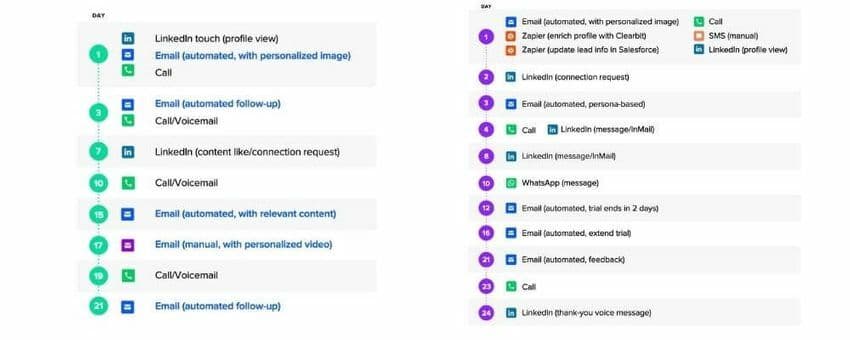
Channels (and touchpoints)
Digging a little deeper, another crucial element of customer engagement is the set of channels (and specific interactions across them) you’re going to use in your sequences. Namely, the main channels are emails, calls or voicemail drops, and social media (e.g., LinkedIn). In some cases, you can also send SMS and chat messages, or even physical mail.
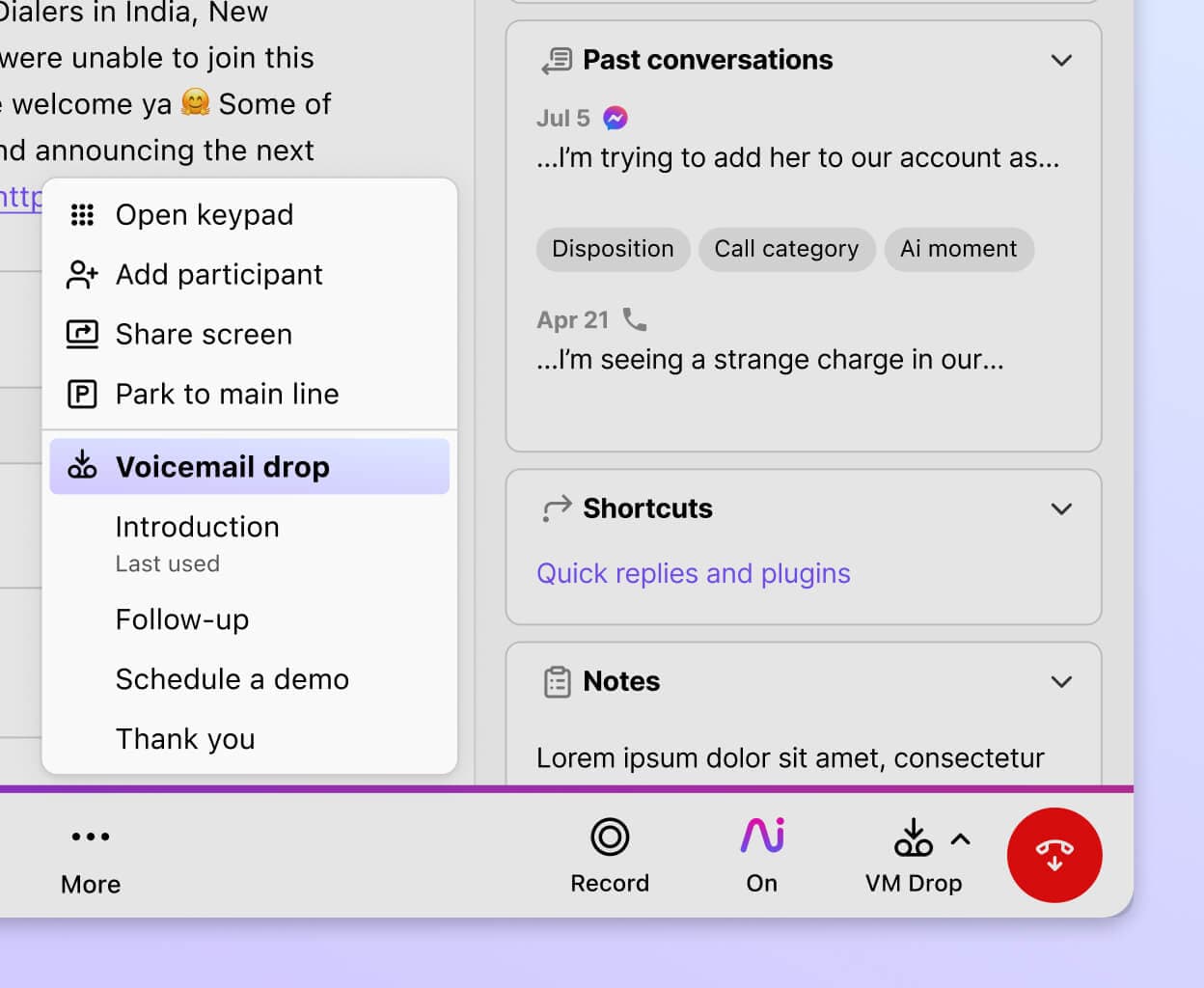
As for the different ways to engage with the prospects, these vary depending on the channel. For example, emails can be automated or manual (mostly personalized), video-based or featuring a custom snippet, etc.
Engaging the prospects on LinkedIn doesn’t necessarily mean harassing them with InMails. Even a simple profile view or subtle interaction with their content can give you a valid reason for outreach and a way to customize your email.
Also, not all steps in your sequences should be direct interactions with the prospect. You can also enrich or verify your contact information, re-target the prospect with LinkedIn or Facebook ads, or trigger other automated actions (e.g., activity-based scenarios such as moving a prospect to a different sequence if they have opened your email more than 5 times) using tools like Zapier.
Analytics
Whether it’s implemented within your sales engagement platform (ideally) or provided by a third-party vendor, having access to detailed reports on your sequence performance is a must. Aside from helping you understand what works and what doesn’t with A/B testing, this will also give you actionable insights on how to improve your performance with sales engagement.
Some key metrics for outbound calls include:
Average handle time (AHT)
Sales per agent
Revenue per successful call
For email, the vital metrics are:
Delivery rate
Open rate
Reply rate
Interested rate
Opt-outs
Talking about call touchpoints, you can create a heatmap of the call volume.
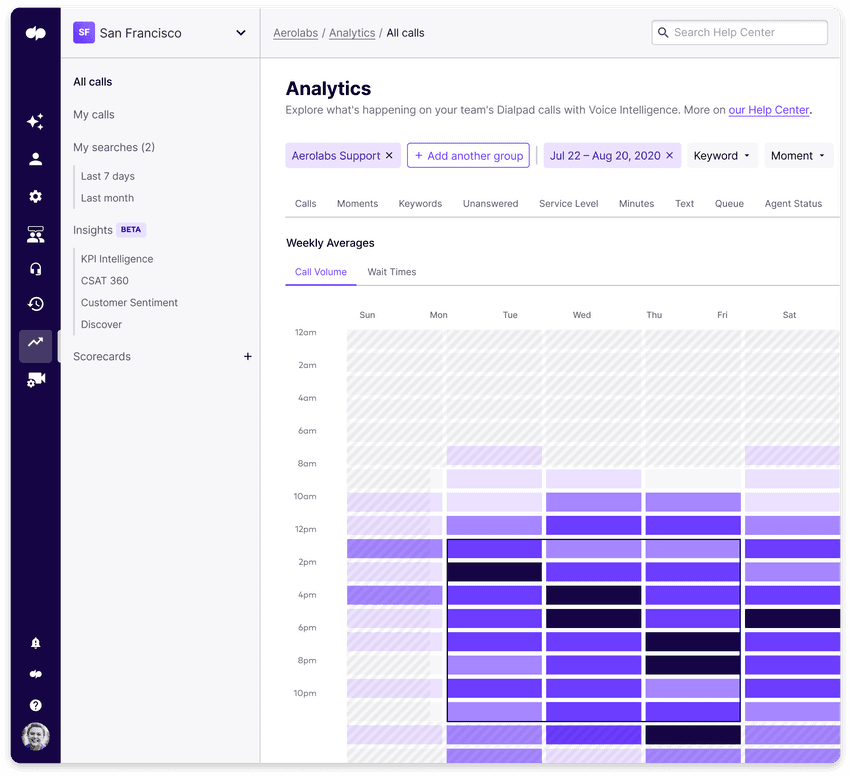
Since it’s difficult to track specific metrics for other channels, you should also be able to view the reports on the level of prospect engagement throughout their journey as a whole.
2. Leverage the best sales engagement technology
If you think that handling all of the listed activities manually is impossible, you’re absolutely right! That is why you need a reliable and solid tech stack to implement your sales engagement strategy.
The most important tool, in this case, is the sales engagement platform (SEP). From building the prospect lists to engaging with prospects to creating tailored sequences around the required channels, it can help you organize and streamline your efforts, making them more efficient and effective.
Sales engagement platforms range in feature set, supported engagement channels, available integrations, price, etc. Similar capabilities might also be provided by a CRM vendor as a part of their product, e.g. Einstein High Velocity Sales Cloud by Salesforce. So, picking the solution that would perfectly match your requirements should be a conscious and informed decision. (Learn more about high velocity sales.)
Aside from the dedicated sales engagement tools, you might need to add the following software to your sales stack:
Prospecting and lead databases: to source and enrich contact lists
Sales intelligence and analytics: to get actionable insights and optimize your efforts
Account-based marketing/sales: to identify and target the right prospects
Sales enablement: to equip the sales teams with the necessary tools and resources
3. Implement proper team training for seamless adoption
Yet, none of the above-listed aspects will lead to any meaningful results if the team doesn’t know how to use them. Building a sales engagement strategy is half the battle. It’s not enough to document your playbooks or purchase the most expensive sales engagement software out there. You need to coach your SDRs to make good use of those too.
For new hires, Reply.io has a 6-week onboarding plan that covers all of the most important aspects of our process helping with frictionless and speedy ramp-up.
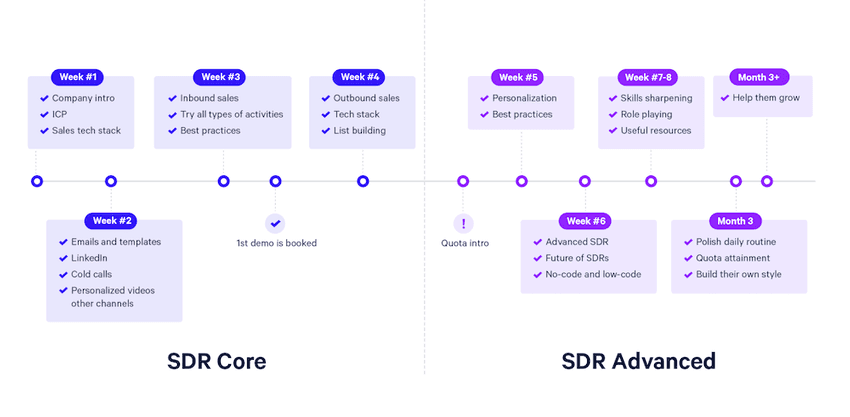
If you are introducing a new sales strategy to your existing team, I recommend the following:
1 on 1 coaching with a sales manager or mentor: feedback, Q&A sessions, etc.
Team plays: group exercises to work through the scripts and playbooks.
Formal processes and checklists documented in your knowledge base or implemented within the tools you rely on.
Technical training, e.g., led by the software vendor when adopting a new tool.
You can also consider hiring a sales consultant, getting professional sales training aid, or even letting your SDRs learn by doing (if you’re ready to fix the mistakes they might make along the way).
Tactics to help you continuously improve sales engagement across your organization
Sales engagement isn’t a new concept. It has been around for years (if not decades). However, the way it is implemented has changed dramatically throughout the years.
The days when the “spray and pray” was the default approach to sales engagement are long gone. As prospects have become resistant to aggressive tactics, sales organizations have come to prioritize personal relationships and trust building as the foundation for engagement.
But it doesn’t stop there. If you want to continuously improve your sales engagement strategy, here are some tactics you should consider:
1. Hyper-personalization
It goes without saying that blasting generic email templates at your prospects is no longer an option. That is called spam and has nothing to do with genuine engagement. The least you should do is include some variables like or to make your message feel as if it was sent to each prospect personally.
But to really future-proof your sequences, you should go one step further with your personalization efforts and adopt advanced variables to tailor your communications based on:
Intent, e.g. recently acquired software, current job openings, growth signals like investments, etc.
Research — any personal information you can find on their social media profiles or other sources, e.g. hobby, achievements, previous experience, etc.
Conditions — additional data fields that are dynamically filled with the given information based on specific conditions, e.g., a greeting in the prospect’s native language based on their location.
Another option is to use 100% custom, research-based snippets in your sales engagement outreach. Similar to the other types of variables, these are specific fields that are filled out with pre-saved custom text fragments for each specific prospect. This approach, however, is extremely time-consuming so I recommend using it only for top-priority leads.
2. Visual prospecting
You can also add personalized images or videos to your outreach messages as a way to stand out from the crowd and show that there’s a real person behind the email. This personalization approach is often referred to as “visual prospecting.” However, it can also be used at other stages of the sales engagement process.
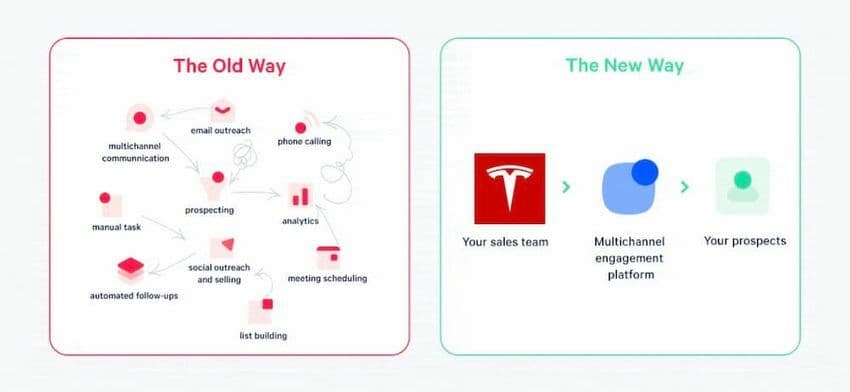
The visual touch within your sequences can be added by using selfie images or videos including customizable text placeholders (as illustrated above), personalized diagrams, screenshots or screencasts, etc.
The best thing about this approach is that it’s not as time-consuming as it might seem. Using dedicated personalization tools, you can generate dynamic images and customize your videos at scale.
3. Multichannel engagement
As mentioned above, interacting with prospects across multiple channels is a must nowadays. In our experience, adopting an omnichannel approach for sales engagement led to a 3x growth in reply rate (from 11% to 29.4%) with twice as many positive responses (from 6% to 14.2%) in just about 6 months.
According to Gartner, 80% of world-class SDR teams employ at least 3 channels with at least 15.5 touches across all of them per contact. So, if you’re only getting started with sales engagement but want to do it right, make sure to cover the following 3 channels:
Emails
Phone calls
Social media
The choice of the latter will mostly depend on the audience you’re targeting. For B2B sales it makes sense to focus primarily on LinkedIn. However, if your audience is active on any other platform, e.g. Twitter or Facebook, it makes sense to explore those channels as well.
4. Intent-based sequences
Last but not the least, an intent-based approach can take your sales engagement to a whole new level. Simply put, this means using the context to personalize and optimize your interactions with the prospects for maximum impact.
What kind of context do you need? Anything that can signal a potential interest in what you have to offer, depending on the type of lead and their current stage in the buying journey.
Two of the most common use cases for intent-based engagement are:
Identifying and engaging outbound leads who have shown any buying signals, whether direct or indirect, e.g. website visits, social media activity related to your industry or competitors, etc.
Tailoring your inbound sequences based on the prospect’s previous activity, e.g. the number of times they have opened your email.
3 common mistakes that might ruin the best sales engagement strategy
Yet, any tactic works well only in capable hands. A poorly implemented sales engagement strategy can backfire and do more harm than good.
And I’m not talking about situations when an SDR sends a personalized email with broken variables that fail to autofill. This is an unfortunate error that can be easily fixed (and even lead to positive results if you handle it with some creativity and humor).
Here are some of the tactical mistakes with sales engagement that many sales teams make:
Having no clear goal in mind. Just like any other initiative, your engagement efforts should be aimed at reaching specific sales objectives, e.g. increase revenue by 10% in Q3, add 30 MQLs to the pipeline each day, or reduce the administrative tasks to one hour per day.
Pushing too hard. Unlike aggressive outbound tactics, sales engagement is more of a “pull” approach, even when targeting cold leads. So, instead of pitching your offer at the first contact, try to build rapport with the prospect and win their trust — even if it takes time.
Not balancing quality and quantity. Having the right sales apps at hand makes it easy to scale your sales engagement efforts. Yet, don’t get carried away with automation as you might end up compromising on the quality of your interactions, e.g. targeting and personalization.
All of the listed mistakes can undermine your sales engagement strategy. But the biggest one would be to have no proper strategy at all.
Ready to power up your sales efforts with a meaningful sales engagement process?
No doubt that engagement is a vital element of any successful sales process. How you interact with the prospects defines the outcomes of their buying journey, overall experience with your business, and their willingness to refer you to their network in the future.
Yet, building and scaling an effective strategy is no easy task. Luckily there are tools like
that help you streamline your sales communications and enable your team with
and
capabilities like
cards that your SDR sees when your prospect says a certain word (such as a competitor).
Keep your prospects engaged
Ready to see how Dialpad can help you with your sales engagement efforts? Book a product tour to learn more!








